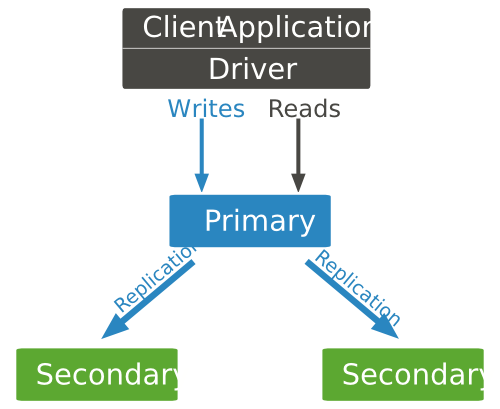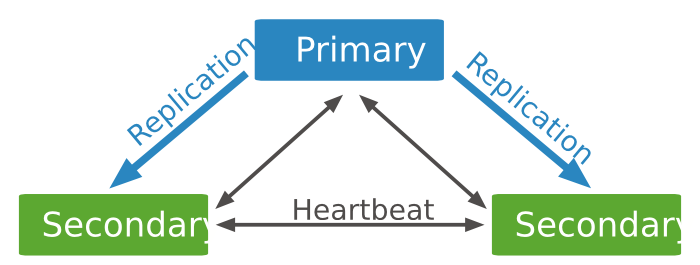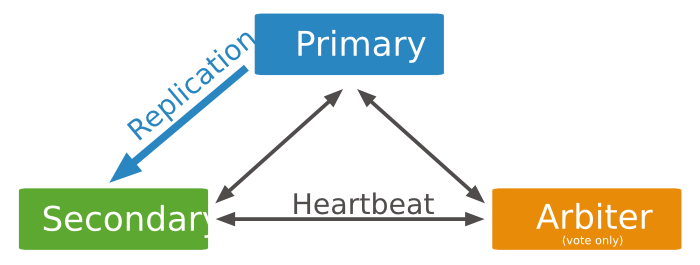- 复制 >
- 复制介绍
复制介绍¶
在某些情况中,我们可以通过复制的方式来提高读的性能。客户端可以将读与写请求分别发送到不同的服务器上。我们还能够通过在其他数据中心建立分布式复制节点的方式来做异地冗灾,以进一步提高可用性。
Redundancy and Data Availability¶
Replication provides redundancy and increases data availability. With multiple copies of data on different database servers, replication provides a level of fault tolerance against the loss of a single database server.
In some cases, replication can provide increased read capacity as clients can send read operations to different servers. Maintaining copies of data in different data centers can increase data locality and availability for distributed applications. You can also maintain additional copies for dedicated purposes, such as disaster recovery, reporting, or backup.
MongoDB中的复制¶
A replica set is a group of mongod instances that maintain the same data set. A replica set contains several data bearing nodes and optionally one arbiter node. Of the data bearing nodes, one and only one member is deemed the primary node, while the other nodes are deemed secondary nodes.
The primary node receives all write operations. A replica set can have only one primary capable of confirming writes with { w: "majority" } write concern; although in some circumstances, another mongod instance may transiently believe itself to also be primary. [1] The primary records all changes to its data sets in its operation log, i.e. oplog. For more information on primary node operation, see 复制集主节点.

The secondaries replicate the primary’s oplog and apply the operations to their data sets such that the secondaries’ data sets reflect the primary’s data set. If the primary is unavailable, an eligible secondary will hold an election to elect itself the new primary. For more information on secondary members, see 复制集从节点.

You may add an extra mongod instance to a replica set as an arbiter. Arbiters do not maintain a data set. The purpose of an arbiter is to maintain a quorum in a replica set by responding to heartbeat and election requests by other replica set members. Because they do not store a data set, arbiters can be a good way to provide replica set quorum functionality with a cheaper resource cost than a fully functional replica set member with a data set. If your replica set has an even number of members, add an arbiter to obtain a majority of votes in an election for primary. Arbiters do not require dedicated hardware. For more information on arbiters, see 投票节点.

An arbiter will always be an arbiter whereas a primary may step down and become a secondary and a secondary may become the primary during an election.
异步复制¶
Secondaries apply operations from the primary asynchronously. By applying operations after the primary, sets can continue to function despite the failure of one or more members. For more information on replication mechanics, see 复制集Oplog and 复制集的数据同步.
自动化故障切换¶
When a primary does not communicate with the other members of the set for more than 10 seconds, an eligible secondary will hold an election to elect itself the new primary. The first secondary to hold an election and receive a majority of the members’ votes becomes primary.
3.2 新版功能: MongoDB introduces a version 1 of the replication protocol (protocolVersion: 1) to reduce replica set failover time and accelerates the detection of multiple simultaneous primaries. New replica sets will, by default, use protocolVersion: 1. Previous versions of MongoDB use version 0 of the protocol.

Read Operations¶
By default, clients read from the primary [1]; however, clients can specify a read preference to send read operations to secondaries. Asynchronous replication to secondaries means that reads from secondaries may return data that does not reflect the state of the data on the primary. For information on reading from replica sets, see 复制集读选项.
In MongoDB, clients can see the results of writes before the writes are durable:
我们也可以为复制集新增一个额外的 mongod 实例作为 投票节点 。投票节点中并不包含数据集,投票节点的作用仅仅是在选举过程中参与投票。当复制集的成员个数为偶数时,添加一个投票节点可以防止平局的出现,通过多数选票来选举出新的主节点。由于投票节点仅提供投票功能,故无需一个专用的物理机。参见 投票节点 获得更多信息。
- Clients using "local" (i.e. the default) readConcern can read data which may be subsequently rolled back.
For more information on read isolations, consistency and recency for MongoDB, see Read Isolation, Consistency, and Recency.
Additional Features¶
Replica sets provide a number of options to support application needs. For example, you may deploy a replica set with members in multiple data centers, or control the outcome of elections by adjusting the members[n].priority of some members. Replica sets also support dedicated members for reporting, disaster recovery, or backup functions.
See 优先级为0的复制集成员, 隐藏节点 and 延时节点 for more information.
| [1] | (1, 2) In some circumstances, two nodes in a replica set may transiently believe that they are the primary, but at most, one of them will be able to complete writes with { w: "majority" } write concern. The node that can complete { w: "majority" } writes is the current primary, and the other node is a former primary that has not yet recognized its demotion, typically due to a network partition. When this occurs, clients that connect to the former primary may observe stale data despite having requested read preference primary, and new writes to the former primary will eventually roll back. |
